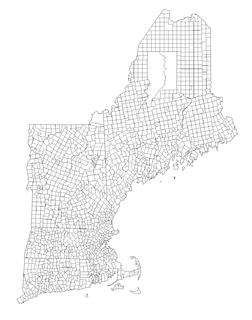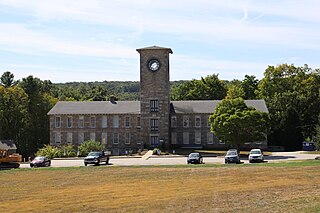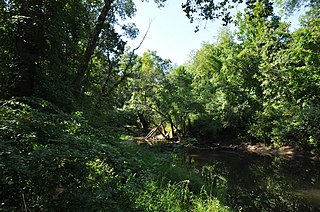| Mansfield Hollow State Park | |
|---|---|
 | |
| Location | Mansfield, Connecticut, United States |
| Coordinates | 41°46′06″N72°10′32″W / 41.76833°N 72.17556°W Coordinates: 41°46′06″N72°10′32″W / 41.76833°N 72.17556°W (boat ramp) |
| Area | 251 acres (102 ha) [1] |
| Elevation | 210 ft (64 m) [2] |
| Designation | Connecticut state park |
| Established | 1952 [3] |
| Administrator | Connecticut Department of Energy and Environmental Protection |
| Website | Mansfield Hollow State Park |
Mansfield Hollow State Park is a public recreation area occupying 251 acres (102 ha) of leased lands on the western shore of 500-acre (200 ha) Mansfield Hollow Lake in the town of Mansfield, Connecticut. [3] The state park is one portion of the 2,300 acres (930 ha) leased by the Connecticut Department of Energy and Environmental Protection from the U.S. Army Corps of Engineers for recreational and wildlife management purposes. [4] Geologic features of the park include remnants of the last glacial period, where retreating glaciers left kames, eskers, and kettles. [5] Recreational opportunities include facilities for boating, fishing, picnicking, hiking, mountain biking, and cross-country skiing. [3] The park is traversed by the southeastern leg of the Nipmuck Trail.

Mansfield Hollow Lake is a reservoir resting on the border of Windham County and Tolland County, Connecticut. The reservoir provides drinking water for Willimantic and helps control flooding in the 159-square-mile Thames River watershed. It was created by the Mansfield Hollow Dam and is entirely contained within Mansfield Hollow State Park and the Mansfield Hollow Wildlife Area. Designed and constructed by the United States Army Corps of Engineers, the dam substantially reduces flooding along the Quinebaug, Shetucket, and Thames rivers. Construction of the project began in 1949 with completion in 1952 at a cost of US$6.5 million. The Mansfield Hollow reservoir is located within the Shetucket River Watershed and is part of the Thames River Basin. Access to the site is available from US Route 6 and State Route 195. The damsite, covering an area of 25 acres (10 ha), was listed on the National Register of Historic Places in 2003.

The New England town, generally referred to simply as a town in New England, is the basic unit of local government and local division of state authority in each of the six New England states and without a direct counterpart in most other U.S. states. New England towns overlay the entire area of a state, similar to civil townships in other states where they exist, but they are fully functioning municipal corporations, possessing powers similar to cities in other states. New Jersey's system of equally powerful townships, boroughs, towns, and cities is the system which is most similar to that of New England. New England towns are often governed by a town meeting legislative body. The great majority of municipal corporations in New England are based on the town model; statutory forms based on the concept of a compact populated place are uncommon, though they are prevalent elsewhere in the U.S. County government in New England states is typically weak at best, and in some states nonexistent. Connecticut, for example, has no county governments, nor does Rhode Island. Both of those states retain counties only as geographic subdivisions with no governmental authority, while Massachusetts has abolished eight of fourteen county governments so far. With few exceptions, counties serve mostly as dividing lines for the states' judicial systems.

Mansfield is a town in Tolland County, Connecticut, United States. The population was 26,543 at the 2010 census.












